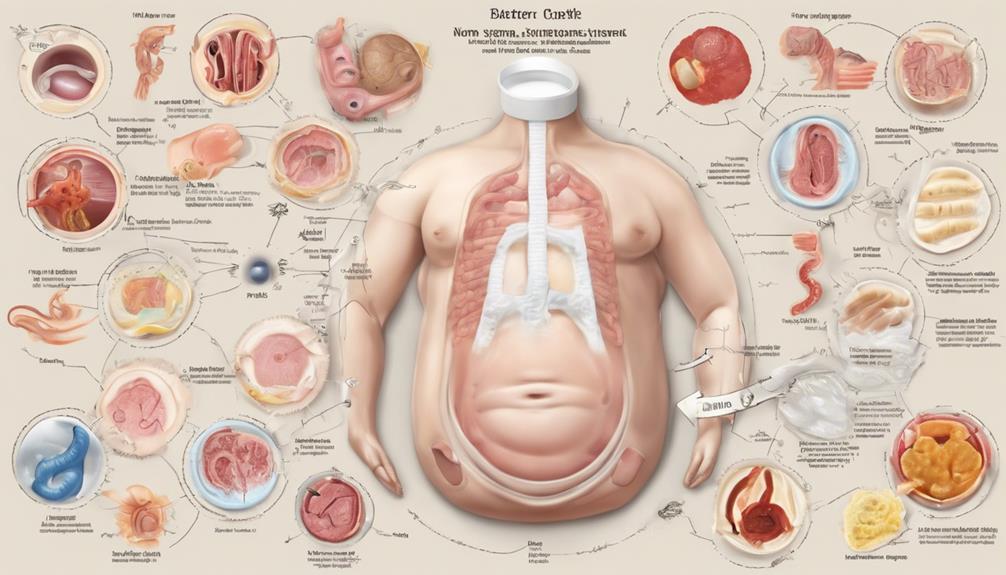When considering the constant cries of a newborn at night, it can be confusing and exhausting. However, learning the root causes of this troubling issue and mastering soothing techniques can make a significant difference for parents.
We've all been there, traversing the hushed halls of a dimly lit nursery, searching for solace in the wee hours of the morning. But fear not, as we uncover practical strategies to ease your baby's cries and guide you towards a more tranquil slumber.
Key Takeaways
- Newborn crying during sleep is normal due to developing nervous system and sleep cycles.
- Techniques like swaddling, white noise, and rocking can help calm a crying newborn.
- Understanding newborn sleep cycles aids in recognizing cues and soothing the baby back to sleep.
- Managing overtiredness by establishing routines and providing comfort improves sleep quality.
Common Reasons for Newborn Crying During Sleep
When newborns cry during sleep, it's often due to their developing nervous system and immature sleep cycles. As caregivers, understanding the reasons behind a baby's cries can provide insight into how we can offer comfort.
Teething pain is a common culprit for these nighttime disruptions, causing discomfort that can lead to crying episodes. Additionally, shifts between sleep cycles may trigger brief moments of crying as the baby adjusts to different stages of rest.
Recognize that crying during sleep is one way newborns communicate their needs or discomfort without fully waking up. By being attuned to these cues, caregivers can respond promptly and provide the necessary comfort to help soothe their little ones back to sleep.
Techniques to Calm a Crying Newborn

To calm a crying newborn, caregivers can utilize various techniques that aim to provide comfort and aid in soothing the baby's distress. Here are three effective methods to help calm a crying newborn:
- Swaddling: Wrapping the baby snugly in a blanket can recreate the feeling of being in the womb, providing a sense of security and reducing the startle reflex that often wakes babies.
- White Noise: Using white noise machines or making gentle shushing sounds can mimic the comforting sounds of the womb environment, helping to calm a crying newborn and lull them to sleep.
- Rocking: Gently rocking or swaying the newborn in your arms or a rocking chair can create a soothing motion that helps relax the baby and can assist in settling them down for sleep.
Understanding Newborn Sleep Cycles

Understanding a newborn's sleep cycles is essential for caregivers to respond effectively to their baby's needs and promote healthy rest. Newborns have shorter sleep cycles, lasting about 50-60 minutes, compared to adults.
These cycles involve moving between light REM sleep and deep non-REM sleep. During these cycles, newborns spend more time in REM sleep, important for brain development and learning. It's normal for newborns to cry during sleep as part of their sleep patterns.
By comprehending newborn sleep cycles, parents can better understand when their baby is in light or deep sleep stages and respond appropriately to their cries. Recognizing these patterns helps in soothing the baby back to sleep or providing comfort during unsettled moments.
Being attuned to the baby's sleep cues and needs is key to fostering a secure sleep environment that supports both the baby's development and the caregiver's ability to respond promptly to their cries.
Tips for Soothing a Teething Baby

Handling a teething baby's discomfort can be challenging, but there are practical ways to provide relief and comfort during this phase. Teething typically starts around 6 months, and it can cause increased drooling, irritability, and disrupted sleep patterns. Here are some tips to help soothe a teething baby:
- Teething Toy: Offering a teething toy for your little one to chew on can help alleviate the pain and pressure they feel on their gums.
- Chilled Washcloth: A chilled (not frozen) washcloth can provide relief by numbing the gums and giving them something safe to chew on.
- Teething Gels or Medications: Consult with your pediatrician about using teething gels or pediatrician-recommended medications to help ease your baby's discomfort.
Managing Overtiredness in Newborns

Newborns experiencing overtiredness often display increased fussiness and struggle to settle down for sleep. It can be challenging to see your little one having difficulty settling, especially when it impacts their sleep quality. Overtired newborns may manifest more night wakings and have trouble self-soothing, leading to sleep disruptions for both baby and caregiver.
To address this, establishing a vital bedtime routine is essential. By creating a consistent wind-down process before sleep, newborns can better unwind and prepare for rest. Additionally, offering extra comfort and assistance to help them calm down can aid in improving their ability to self-soothe.
Promptly managing overtiredness not only reduces fussiness but also promotes better sleep quality. Remember, a well-rested baby is a happier baby, and by supporting them through their difficulty settling, you pave the way for more peaceful nights and brighter mornings.
Frequently Asked Questions
How Can I Soothe My Baby's Crying in His Sleep?
We can comfort our baby's sleep crying by using gentle belly rubs, soothing words, white noise, shushing, rocking, or a pacifier. Breastfeeding can help them relax. Create a cozy sleep environment with the right temperature and bedding. Patience is key.
Should I Comfort Baby Crying in Sleep?
We sometimes hesitate to comfort a crying baby during sleep, but it is crucial to trust our instincts and respond if needed. Checking basic needs and maintaining a peaceful environment can help soothe them back to sleep.
Why Does My Newborn Suddenly Cry While Sleeping?
Sometimes newborns cry while sleeping due to normal nervous system development, REM sleep, teething pain, or changing sleep cycles. It's their way of communicating and self-soothing. Understanding these reasons can help us support them better.
Is It OK to Let a Newborn Cry Themselves to Sleep?
It's important not to let a newborn cry themselves to sleep. Responding promptly to their cries helps build trust and security. Comforting them during sleep promotes healthy attachment and regulates their stress response.
Can Twitching in Sleep Cause a Newborn to Cry?
Twitching in sleep can be one of the reasons for newborn twitching, leading to crying. This involuntary movement is normal for newborns as they experience rapid eye movement (REM) sleep. It may be due to their developing nervous system. However, consulting a pediatrician is recommended for any concerns.
Conclusion
To sum up, helping a newborn through their crying episodes during sleep can be a challenging yet rewarding experience. By using gentle techniques and understanding their needs, we can create a peaceful environment for them to rest and grow.
Remember, each baby is unique, and it's important to be patient and responsive to their cues.
With time and practice, soothing a crying newborn during sleep can become a comforting and bonding experience for both baby and caregiver.










